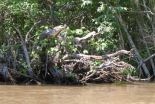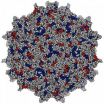(Press-News.org) CHICAGO --- A new imaging technique for measuring blood flow in the heart and vessels can diagnose a common congenital heart abnormality, bicuspid aortic valve, and may lead to better prediction of complications.
A Northwestern Medicine team reported the finding in the journal Circulation. In the study, the authors demonstrated for the first time a previously unknown relationship between heart valve abnormalities, blood flow changes in the heart and aortic disease. They showed that blood flow changes were driven by specific types of abnormal aortic valves, and they were able to directly associate blood flow patterns with aortic diseases.
"Blood flow in patients with bicuspid aortic valves was significantly different compared to that in patients with normal valves," said senior author Michael Markl, associate professor of radiology at Northwestern University Feinberg School of Medicine. "We now have direct evidence that bicuspid valves induce changes in blood flow and that the type of flow abnormality may contribute to the development of different expressions of heart disease in these patients."
Bicuspid aortic valve is a heart condition in which the aortic valve only has two leaflets, instead of the normal three. It affects approximately one to two of every 100 Americans and is the most common congenital cardiovascular abnormality. Despite the absence of symptoms, the condition can lead to significant and potentially life-threatening complications, including enlargement of the blood vessel (aneurysm) and rupture. However, it is not known which patients are at the highest risk for complications and whether the condition's origin is genetic or related to changes in blood flow.
The 4D flow MRI (magnetic resonance imaging) used in the study has the potential for better predictive ability.
"The study demonstrated that new imaging techniques may help to determine patient-specific changes in blood flow to better understand which regional areas of the aorta are most prone to developing disease," Markl said. "In addition, the knowledge of abnormal blood flow patterns could be important to better identify patients at risk for the development of heart disease."
Markl's team was surprised to see such a clear distinction between individual expressions of aortic complications for different types of congenital valve disease. While the current findings show evidence of this link, long-term observational studies are needed to better understand the potential of 4D flow MRI to improve disease prediction ability.
A longitudinal follow-up study in patients with bicuspid aortic valves is currently underway at Northwestern.
"Ultimately, we hope that this imaging technique will facilitate early identification of high-risk blood flow patterns associated with progressive aortic enlargement, improving the allocation of health care resources in caring for patients with this prevalent condition," Markl said.
INFORMATION:
This research was supported by the National Heart, Lung and Blood Institute of the National Institutes of Health (NIH), grant R01HL115828, and by Northwestern University Clinical and Translational Sciences Institute NIH grant UL1RR025741. The research also was supported by the Northwestern Memorial Foundation Dixon Translational Research Grants Initiative, American Heart Association Scientist Development Grant and the Northwestern Bicuspid Aortic Valve Program at the Bluhm Cardiovascular Institute.
Related videos are available at: https://www.youtube.com/user/NURadiology.
NORTHWESTERN NEWS: http://www.northwestern.edu/newscenter
New imaging technique can diagnose common heart condition
Technique to measure blood flow is first to diagnose aortic disease and may predict complications
2014-02-12
ELSE PRESS RELEASES FROM THIS DATE:
Four new galaxy clusters take researchers further back in time
2014-02-12
Four unknown galaxy clusters each potentially containing thousands of individual galaxies have been discovered some 10 billion light years from Earth.
An international team of astronomers, led by Imperial College London, used a new way of combining data from the two European Space Agency satellites, Planck and Herschel, to identify more distant galaxy clusters than has previously been possible. The researchers believe up to 2000 further clusters could be identified using this technique, helping to build a more detailed timeline of how clusters are formed.
Galaxy clusters ...
Thatcher's policies condemned for causing 'unjust premature death'
2014-02-12
Dr Alex Scott-Samuel and colleagues from the Universities of Durham, West of Scotland, Glasgow and Edinburgh, sourced data from over 70 existing research papers, which concludes that as a result of unnecessary unemployment, welfare cuts and damaging housing policies, the former prime minister's legacy "includes the unnecessary and unjust premature death of many British citizens, together with a substantial and continuing burden of suffering and loss of well-being."
Speaking about the figures, Dr Scott-Samuel said: "Towards the end of the 1980s we were seeing around 500 ...
Better RNA interference, inspired by nature
2014-02-11
CAMBRIDGE, MA -- Inspired by tiny particles that carry cholesterol through the body, MIT chemical engineers have designed nanoparticles that can deliver snippets of genetic material that turn off disease-causing genes.
This approach, known as RNA interference (RNAi), holds great promise for treating cancer and other diseases. However, delivering enough RNA to treat the diseased tissue, while avoiding side effects in the rest of the body, has proven difficult.
The new MIT particles, which encase short strands of RNA within a sphere of fatty molecules and proteins, silence ...
University of Tennessee study finds crocodiles climb trees
2014-02-11
When most people envision crocodiles, they think of them waddling on the ground or wading in water—not climbing trees. However, a University of Tennessee, Knoxville, study has found that the reptiles can climb trees as far as the crowns.
Vladimir Dinets, a research assistant professor in the Department of Psychology, is the first to thoroughly study the tree-climbing and -basking behavior. The research is published in the journal Herpetology Notes and can be found at http://bit.ly/Myi8yr.
Dinets and his colleagues observed crocodile species on three continents—Australia, ...
Caltech-developed method for delivering HIV-fighting antibodies proven even more promising
2014-02-11
In 2011, biologists at the California Institute of Technology (Caltech) demonstrated a highly effective method for delivering HIV-fighting antibodies to mice—a treatment that protected the mice from infection by a laboratory strain of HIV delivered intravenously. Now the researchers, led by Nobel Laureate David Baltimore, have shown that the same procedure is just as effective against a strain of HIV found in the real world, even when transmitted across mucosal surfaces.
The findings, which appear in the February 9 advance online publication of the journal Nature Medicine, ...
The content of our cooperation, not the color of our skin
2014-02-11
It's widely acknowledged that a common threat unites people. Individuals who were previously separated by social class, race or ethnicity come together, forming new cooperative alliances to defeat a common enemy. But does it take an external threat — an attack like Pearl Harbor or 9/11 — to make these social divisions melt away?
A study by behavioral scientists at UC Santa Barbara demonstrates that peaceful cooperation has the same effect as intergroup conflict in erasing social boundaries connected to race. Their findings appear today in the journal PLOS ONE.
"Evolution ...
Fish living near the equator will not thrive in the warmer oceans of the future
2014-02-11
According to an international team of researchers, the rapid pace of climate change is threatening the future presence of fish near the equator.
"Our studies found that one species of fish could not even survive in water just three degrees Celsius warmer than what it lives in now," says the lead author of the study, Dr Jodie Rummer from the ARC Centre of Excellence for Coral Reef Studies (Coral CoE) at James Cook University.
Dr Rummer and her colleagues studied six common species of fish living on coral reefs near the equator. She says many species in this region only ...
How our brain networks: Research reveals white matter 'scaffold' of human brain
2014-02-11
For the first time, neuroscientists have systematically identified the white matter "scaffold" of the human brain, the critical communications network that supports brain function.
Their work, published Feb. 11 in the open-source journal Frontiers in Human Neuroscience, has major implications for understanding brain injury and disease. By detailing the connections that have the greatest influence over all other connections, the researchers offer not only a landmark first map of core white matter pathways, but also show which connections may be most vulnerable to damage.
"We ...
Scientists identify gene linking brain structure to intelligence
2014-02-11
For the first time, scientists at King's College London have identified a gene linking the thickness of the grey matter in the brain to intelligence. The study is published today in Molecular Psychiatry and may help scientists understand biological mechanisms behind some forms of intellectual impairment.
The researchers looked at the cerebral cortex, the outermost layer of the human brain. It is known as 'grey matter' and plays a key role in memory, attention, perceptual awareness, thought, language and consciousness. Previous studies have shown that the thickness of ...
New research sheds light on how the body regulates fundamental neuro-hormone
2014-02-11
New research has revealed a previously unknown mechanism in the body which regulates a hormone that is crucial for motivation, stress responses and control of blood pressure, pain and appetite. The breakthrough could be used to design drugs to help fight health problems connected with these functions in the future.
Researchers at the University of Bristol and University College London found that lactate – essentially lactic acid – causes cells in the brain to release more noradrenaline (norepinephrine in US English), a hormone and neurotransmitter which is fundamental ...
LAST 30 PRESS RELEASES:
Structure of dopamine-releasing neurons relates to the type of circuits they form for smell-processing
Reducing social isolation protects the brain in later life
Keeping the heart healthy increases longevity even after cancer
Young adults commonly mix cannabis with nicotine and tobacco
Comprehensive review illuminates tau protein's dual nature in brain health, disease, and emerging psychiatric connections
Book prepares K-12 leaders for the next public health crisis
Storms in the Southern Ocean mitigates global warming
Seals on the move: Research reveals key data for offshore development and international ecology
Sports injuries sustained during your period might be more severe
World's first successful 2 Tbit/s free-space optical communication using small optical terminals mountable on satellites and HAPS
Can intimate relationships affect your heart? New study says ‘yes’
Scalable and healable gradient textiles for multi‑scenario radiative cooling via bicomponent blow spinning
Research shows informed traders never let a good climate crisis go to waste
Intelligent XGBoost framework enhances asphalt pavement skid resistance assessment
Dual-function biomaterials for postoperative osteosarcoma: Tumor suppression and bone regeneration
New framework reveals where transport emissions concentrate in Singapore
NTP-enhanced lattice oxygen activation in Ce-Co catalysts for low-temperature soot combustion
Synergistic interface engineering in Cu-Zn-Ce catalysts for efficient CO2 hydrogenation to methanol
COVID-19 leaves a lasting mark on the human brain
Scientists use ultrasound to soften and treat cancer tumors without damaging healthy tissue
Community swimming program for Black youth boosts skills, sense of belonging, study finds
Specific depressive symptoms in midlife linked to increased dementia risk
An ‘illuminating’ design sheds light on cholesterol
Who is more likely to get long COVID?
Study showcases resilience and rapid growth of “living rocks”
Naval Research Lab diver earns Office of Naval Research 2025 Sailor of the Year
New Mayo-led study establishes practical definition for rapidly progressive dementia
Fossil fuel industry’s “climate false solutions” reinforce its power and aggravate environmental injustice
Researchers reveal bias in a widely used measure of algorithm performance
Alcohol causes cancer. A study from IOCB Prague confirms damage to DNA and shows how cells defend against it
[Press-News.org] New imaging technique can diagnose common heart conditionTechnique to measure blood flow is first to diagnose aortic disease and may predict complications



